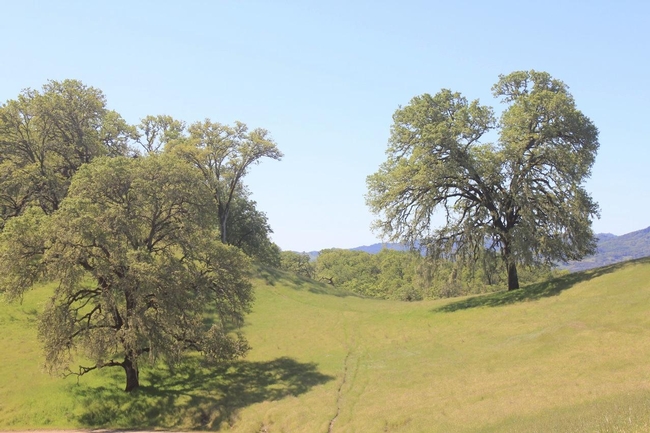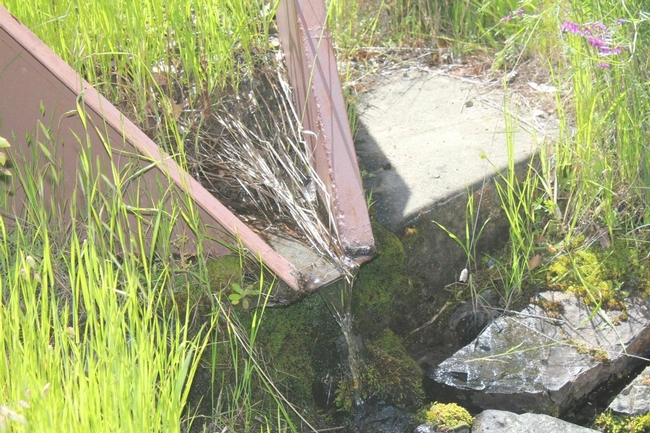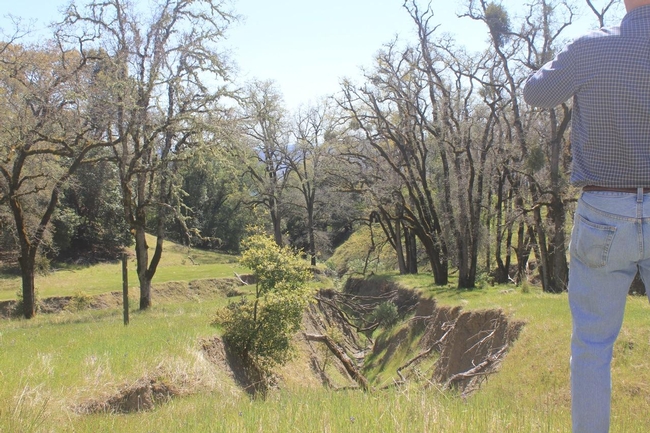This year’s delayed “rainy season” in much of California has left many seasonal water sources for wildlife and livestock dry and kept many of the state’s water reservoirs low. If the “rainy season” progresses without rain we may find ourselves thinking about how we capture as much rainfall as possible not only in our soils but also in our ponds and reservoirs. In other words, how do we manage our watersheds for maximum water yield?
Vegetation affects the hydrologic cycle through evapotranspiration and the interception of water. Both processes are a direct function of the type and density of vegetation present in the watershed. On one hand, natural vegetation in California is continually being lost to housing development, conversion to agricultural crops, sudden oak death syndrome and wildfire. On the other hand, undistributed rangelands in some parts of the state are reverting to woody vegetation.
A study conducted at Hopland Research and Extension Center (HREC) in the 1950’s sheds some light on vegetation effects on water yield, at least for north coast watersheds in California (Dahlgren et. al. 2001). Beginning in the early 1950’s, a series of watershed studies was undertaken on experimental watersheds at the HREC in Mendocino County. The watersheds ranged from 30 to 210 acres. All have relatively steep slopes, from 20 to 60%. The climate at Hopland is Mediterranean, with a mean annual precipitation of 37 inches and a mean annual temperature of 57 F. Soils in the watersheds are moderately developed and shallow, rarely exceeding 3 to 4 feet deep.

In 1952, Watershed I (63 acres) and Watershed II (210 acres) were fitted with instruments, including precipitation gauges, stream runoff measuring stations and debris basins for sediment transport measurements. Both watersheds were located a lower elevations (500 to 1,000 ft) with typical oak woodland vegetation. Baseline data was collected for several years. In 1956 vegetation from Watershed I was mechanically removed, followed by burning of woody materials, treatment of stumps with herbicide, and seeding with a grass-legume mixture. Between 1960 and 1965, vegetation in Watershed II was killed with herbicide. Dead trees were left in place. In 1965, Watershed II was burned and reseeded with a grass-legume mixture. Vegetation, stream flow and sediment data were collected from Watershed I and II for over a decade following vegetation conversion on each watershed.
Vegetation and Water Yield Findings
The researchers found that converting woodlands to grass vegetation retarded runoff during storms, and resulted in nearly a doubling in the length of storm hydrographs from both watersheds (Hydrographs plot the flow or discharge of a waterway through time). After conversion to grass vegetation, peak runoff rates were reduced by about 25% compared to pretreatment storms. This result is different from that realized in other studies conducted in other woodland and forest systems elsewhere in the world.
The longer hydrograph responses indicated a longer, slower period of runoff with greater contribution of water from subsurface flows. These changes resulted from an increase in grass cover that retarded overland flow and permitted more opportunities for infiltration. The removal of the deep-rooted trees also resulted in a long-term increase in runoff and an extension of base flow through the dry season. After vegetation was converted, intermittent streams became perennial in both Watershed I and II.
After conversion to grassland in these watersheds, stream discharge increased by an average of 60%. However, in pre and post treatment condition, there was a high correlation between runoff and total precipitation. There was also a season affect that should be considered. March was the critical month in the runoff process. During the rainy period leading up to March, the increase of water yield in the converted watersheds was definite. During March, the effect of conversion was variable, sometime positive and sometimes negative. This behavior may be explained by examining the growth patterns of grasses and oak vegetation. At the experimental site in Mendocino County, warm temperatures in March promote the growth of grasses, resulting in increased evapotranspiration. In contrast, deciduous oak trees are not in full leaf in March, resulting in less water loss to interception and evaportranspiration. Rainfall in April and May often produces no runoff due to high evapotranspiration demands, especially after deciduous trees leaf out.

erosion during rainy seasons
These experimental results have important ramifications for vegetation and land use throughout the California Coastal Range. Decreased peak flows during storms and reduced flood hazards may be among the benefits of maintaining grasslands and preventing the encroachment of woody species. The increase annual water yield including the increase in summer and fall base flows may have important benefits for anadramous fish species and the health and integrity of the aquatic ecosystem. Similarly, the change in ephemeral streams to perennial streams may improve wildlife habitat by providing a summer source of water.
It should be noted that with these increased stream flows in the converted watersheds came significant erosion problems. Although a lot of the mass-wasting events observed after the conversion treatment were associated with tree and shrub removal, the loss of root systems in providing reinforcement and the increase in soil-moisture were also factors. In any case, given needs for water quality and quantity careful consideration should be given to managing and maintaining the type of vegetation that produces desired results.

Author: Sheila Barry, UCCE Livestock and Natural Resources Advisor, San Francisco CA
Literature Cited
Dahlgren, R.A. et al. 2001. Watershed research examines rangeland management effects on water quality. California Agriculture 55:6:64-71. http://californiaagriculture.ucop.edu/0106ND/pdfs/watershed1771.pdf